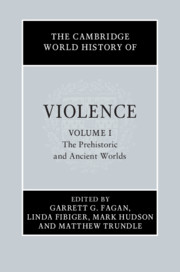Book contents
- The Cambridge World History of Violence
- The Cambridge History of Violence
- The Cambridge World History of Violence
- Copyright page
- Contents
- Figures
- Maps
- Contributors to Volume i
- General Introduction: Violence in World History
- Introduction to Volume I
- Part I The Origins of Conflict
- 1 The Origins of Warfare and Violence
- 2 Violence in Palaeolithic and Mesolithic Hunter-Gatherer Communities
- 3 Settled Lives, Unsettled Times: Neolithic Violence in Europe
- 4 Violence during the Later Stone Age of Southern Africa
- 5 Weapons, Warriors and Warfare in Bronze Age Europe
- 6 Weapons, Ritual and Warfare: Violence in Iron Age Europe
- 7 The Origins of Violence and Warfare in the Japanese Islands
- Part II Prehistoric and Ancient Warfare
- Part III Intimate and Collective Violence
- Part IV Religion, Ritual and Violence
- Part V Violence, Crime and the State
- Part VI Representations and Constructions of Violence
- Index
- References
7 - The Origins of Violence and Warfare in the Japanese Islands
from Part I - The Origins of Conflict
Published online by Cambridge University Press: 13 March 2020
- The Cambridge World History of Violence
- The Cambridge History of Violence
- The Cambridge World History of Violence
- Copyright page
- Contents
- Figures
- Maps
- Contributors to Volume i
- General Introduction: Violence in World History
- Introduction to Volume I
- Part I The Origins of Conflict
- 1 The Origins of Warfare and Violence
- 2 Violence in Palaeolithic and Mesolithic Hunter-Gatherer Communities
- 3 Settled Lives, Unsettled Times: Neolithic Violence in Europe
- 4 Violence during the Later Stone Age of Southern Africa
- 5 Weapons, Warriors and Warfare in Bronze Age Europe
- 6 Weapons, Ritual and Warfare: Violence in Iron Age Europe
- 7 The Origins of Violence and Warfare in the Japanese Islands
- Part II Prehistoric and Ancient Warfare
- Part III Intimate and Collective Violence
- Part IV Religion, Ritual and Violence
- Part V Violence, Crime and the State
- Part VI Representations and Constructions of Violence
- Index
- References
Summary
This chapter examines the origins and early history of violence in the Japanese Islands, focusing on the Jomon (c. 14,500–900 BCE) and Yayoi (c. 900 BCE– 250 CE) periods. For several reasons the Japanese archipelago is a good place to think about links between violence and historical change. It possesses a long sequence of hunter-gatherer settlement that can contribute to ongoing debates over violence and agriculture. Hunter-gatherers in the Japanese Islands display great diversity due to both ecological and historical factors. The fact that many in prehistoric Japan were engaged in plant cultivation, leads us to a third factor: if agriculture was an important stimulus behind organised warfare, then at what point along the continuum between forager cultivation and full-scale farming did violence take on that new mantle? Finally, the position of Japan at the periphery of the East Asian world system offers the opportunity to investigate the role of ‘tribal zone’ and similar colonial processes in contexts very different from those theorised in the existing literature.
Keywords
- Type
- Chapter
- Information
- The Cambridge World History of Violence , pp. 160 - 178Publisher: Cambridge University PressPrint publication year: 2020
References
Bibliographic Essay
- 2
- Cited by

